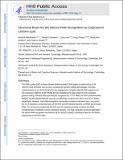Structural basis for the altered PAM recognition by engineered CRISPR-Cpf1
Author(s)
Nishimasu, Hiroshi; Yamano, Takashi; Gao, Linyi; Zhang, Feng; Ishitani, Ryuichiro; Nureki, Osamu; ... Show more Show less
DownloadAccepted version (901.8Kb)
Terms of use
Metadata
Show full item recordAbstract
The RNA-guided Cpf1 nuclease cleaves double-stranded DNA targets complementary to the CRISPR RNA (crRNA), and it has been harnessed for genome editing technologies. Recently, Acidaminococcus sp. BV3L6 (AsCpf1) was engineered to recognize altered DNA sequences as the protospacer adjacent motif (PAM), thereby expanding the target range of Cpf1-mediated genome editing. Whereas wild-type AsCpf1 recognizes the TTTV PAM, the RVR (S542R/K548V/N552R) and RR (S542R/K607R) variants can efficiently recognize the TATV and TYCV PAMs, respectively. However, their PAM recognition mechanisms remained unknown. Here we present the 2.0 Å resolution crystal structures of the RVR and RR variants bound to a crRNA and its target DNA. The structures revealed that the RVR and RR variants primarily recognize the PAM-complementary nucleotides via the substituted residues. Our high-resolution structures delineated the altered PAM recognition mechanisms of the AsCpf1 variants, providing a basis for the further engineering of CRISPR-Cpf1.
Date issued
2017-07Department
Broad Institute of MIT and Harvard; McGovern Institute for Brain Research at MIT; Massachusetts Institute of Technology. Department of Brain and Cognitive SciencesJournal
Molecular Cell
Publisher
Elsevier BV
Citation
Nishimasu, Hiroshi et al. "Structural basis for the altered PAM recognition by engineered CRISPR-Cpf1." Molecular Cell 67, 1 (July 2017): 139-47 ©2017 Author(s)
Version: Author's final manuscript
ISSN
1097-2765
1097-4164